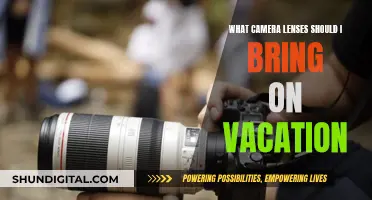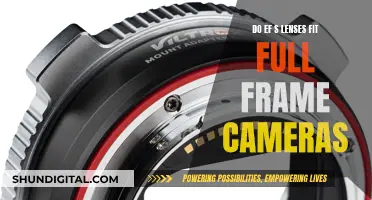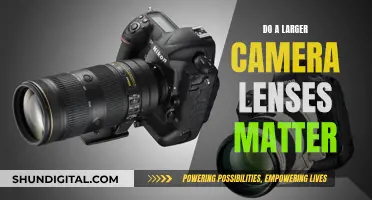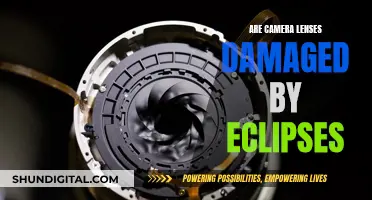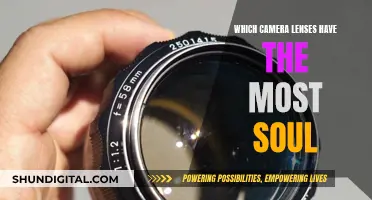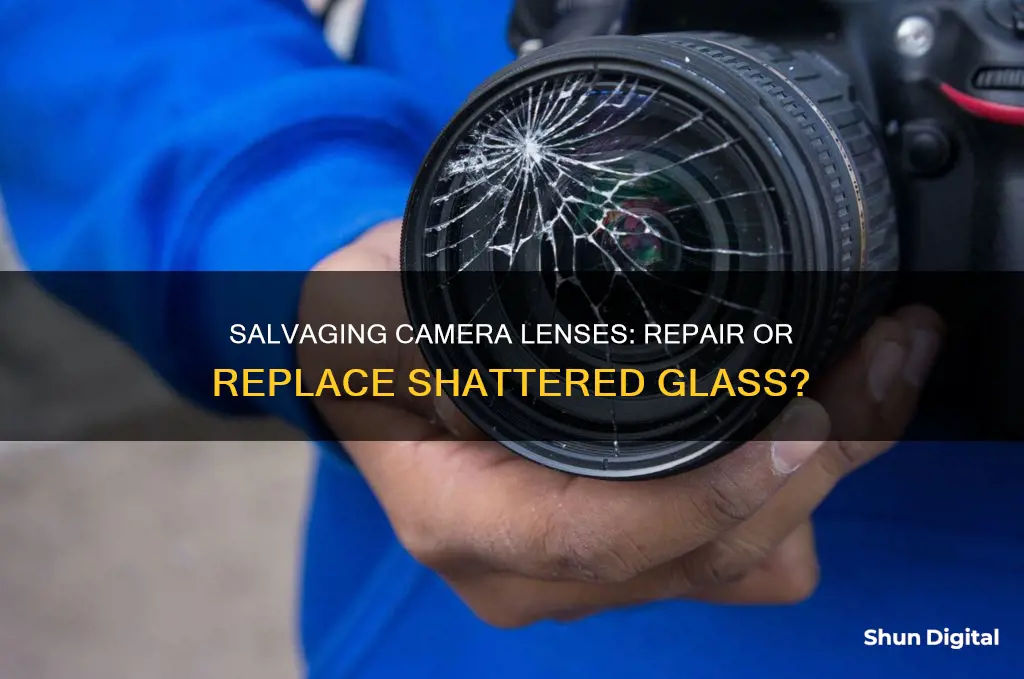
Shattered camera lenses can be a nightmare for photographers. While it's possible to fix a broken camera lens, it's not recommended to do it yourself as you may end up causing more damage. Instead, it's best to send the lens for inspection by a professional, who will advise on whether it can be repaired and provide a quote for their services. If the lens is too damaged or the repair is too costly, you may need to invest in a new lens.
What You'll Learn

Check if the lens is broken or just needs cleaning
Before you start testing your camera lens, check for any physical damage. Turn the zoom and focusing rings to see if everything moves smoothly and listen out for any unusual sounds.
Then, look at the front element of the lens and shine a light from different angles to check for scratches on the glass elements. Next, examine the sealing of the lens and the lens mount, and look for scratches on the lens body.
Now, attach the lens to your camera and take some test shots. First, check the autofocus to see if there are any issues. On the photos, look for any uneven focus, check if the image is sharp enough, and look out for excessive chromatic aberration and vignetting.
You can compare the photos you took with the ones published online to see if your lens delivers the same quality. Then, do a sharpness test – make sure you use a tripod to avoid any camera shake. You can download sharpness tests from the web, or you can photograph something flat and parallel to the camera, such as a brick wall.
Put the lens in manual focusing mode, then focus and defocus your subject to see if the centre stays in the centre and that both sides of the image focus and defocus simultaneously. Then check if everything is equally sharp across the frame.
Finally, do a focus accuracy test to see if it’s back or forward focusing – you can do this with a calibration chart. Many lenses can be fine-tuned on your own. Try using the lens software when available – otherwise, send it back for calibration.
Cleaning Your Fujifilm XP Waterproof Camera Lens
You may want to see also

Send it for repair
If you have a shattered camera lens, it is best to send it for repair by a professional. While you can attempt to fix a broken camera lens yourself, it is not recommended as you may inadvertently cause more damage and you will usually need specialist equipment to do the repair properly.
First, you need to determine what the problem is. If you're receiving an error message, the lens likely has a software issue. Try updating the firmware to see if that fixes the problem. If the lens is not delivering sharp images, it may just need calibration. There are different tools to check this, and in many cases, you can adjust it inside the camera or by using the lens software.
If you don't know what's causing the issue, you can send the lens for an inspection by a professional. In some cases, this is free of charge. They will tell you what's wrong and whether or not it can be fixed. They will also give you an estimate for their services if you want it to be repaired by them. This is the best choice to ensure your lens is properly repaired.
When something is wrong with your camera lens, you can go directly to the manufacturer or a third-party repair shop, which is usually cheaper. However, be careful and make sure the repair centre is trustworthy and, better yet, authorised by the manufacturer. Each brand usually has local representatives, and you can typically find this information in the manual or online.
Remember, a lens is a delicate piece of equipment with multiple glass elements and moving parts, so it's always best to have it repaired by a professional if you can.
Camera Lenses for DSLRs: Are They Piratical and Affordable?
You may want to see also

Try to fix it yourself
If your camera lens is shattered, there are a few things you can try to fix it yourself before taking it to a repair shop or buying a new one. Here are some steps you can take:
- Inspect the damage: Before attempting any repairs, carefully inspect the lens for any visible damage. Look for scratches, cracks, or gouges on the lens surface and housing.
- Remove broken glass: If there are any broken pieces of glass, use precision tweezers to carefully remove them from the camera lens housing and the surrounding area. Be extremely gentle and precise during this step to avoid further damage or injury. Wear eye protection to shield your eyes from any flying glass fragments.
- Clean the lens area: Once all the broken glass has been removed, clean the contours of the camera lens area and housing to get rid of any remaining glass fragments and dust.
- Acquire a replacement lens: You will need to purchase a new lens that is compatible with your specific camera model. Make sure to get the correct colour and size for your phone. You can usually find replacement lenses online or at electronics stores.
- Attach the new lens: Use a small amount of adhesive or clear superglue to attach the replacement lens to the camera housing. Be very precise when positioning the new lens, as you don't want to smear the glue. Apply light pressure to secure the lens in place.
- Test the camera: After the glue has dried, test your camera to check if the new lens is working properly. Take some photos or videos to ensure that the images are sharp and clear.
- Clean the lens: Use a microfiber cloth to gently clean the new lens, removing any fingerprints or dust.
It is important to note that repairing a shattered camera lens can be challenging, and there is a risk of further damaging the camera or injuring yourself if the repair is not done correctly. If you are uncomfortable performing the repair yourself, it is best to seek the help of a professional or consider purchasing a new camera lens.
CPU in Camera Lenses: What Does It Mean?
You may want to see also

Use it for spare parts
If you have a shattered camera lens, you could consider using it for spare parts. Here are some ideas for what you can do with the different components:
- Lens mount: If your lens mount is broken, it may be possible to replace it with a new one. This part is usually affordable and can be replaced by unscrewing the damaged part and screwing in the new one. However, it is important to be careful with the contact plate so that the camera and lens can still communicate.
- Glass elements: If the glass elements inside your lens are damaged, they can be replaced. This can be a complex process, and it may be more cost-effective to buy a new lens. However, if you are confident in your abilities, you can find instructions online for disassembling and reassembling your specific lens model.
- Focus ring: If your focus ring is not turning, you may be able to fix it by disassembling the lens and identifying the issue. Online forums and communities can be a helpful resource for troubleshooting and repair advice.
- Lens software: If your lens is displaying error messages or having issues with autofocus, you may be able to fix it by updating the firmware.
- Lens body and external parts: The external parts of the lens are generally easier to fix or replace than the internal elements. However, it is still important to be careful when disassembling and reassembling the lens to avoid causing further damage.
Before attempting any repairs or taking your lens apart, be sure to clean it thoroughly to remove any dust, debris, or glass shards that could cause issues.
Lens Thread Compatibility: A Universal Camera Feature?
You may want to see also

Make something decorative out of it
If you have a shattered camera lens, there are several ways to make something decorative out of it. Here are some ideas:
Create a Vintage Decorative Piece
You can create a vintage decorative piece by taking an old camera and giving it a new coat of paint. This can be a fun and creative way to upcycle your broken lens, transforming it into a unique piece of pop art that adds a touch of retro charm to your space.
Make a Camera Vase
Turn your broken camera lens into a vase by adding a waterproof lining to its interior. This way, you can showcase your love for photography while displaying beautiful florals. Silverstone resin, for example, can be used to prevent rust and ensure your vase lasts for years to come.
Design a Camera-Themed Night Light
Craft a camera-themed night light by shining light through the front of the lens. This idea is perfect for creating a subtle glow in a hallway or any other space in your home. You can even experiment with different colours and angles to create a unique ambiance.
Build a Camera Lamp
Vintage cameras with large, round flashes can be converted into eye-catching tabletop or desktop lamps. Alternatively, you can create a stacked camera lamp by combining three different generations of cameras, blending photography and illumination in a single piece.
Craft a Camera Bracelet
Disassemble your broken camera lens and turn its components into a stylish bangle. This idea is perfect if you're looking for a subtle way to showcase your passion for photography. You can even experiment with different colours and finishes to create a one-of-a-kind accessory.
Make a Camera-Shaped Pillow
Surround yourself with comfort and your favourite hobby by crafting a camera-shaped pillow. This idea is perfect for those who love to flick through their latest shots while relaxing on the couch or in bed. You can even add personal touches to make it truly yours.
There are endless possibilities for upcycling a shattered camera lens into something decorative. Whether you opt for a functional piece like a lamp or a purely aesthetic creation like a painted camera sculpture, the choice is yours. Get creative, and you'll be surprised at what you can achieve!
Capturing Distance: 300mm Lens Vision Explored
You may want to see also
Frequently asked questions
If your camera lens is shattered, you can try to fix it yourself, but this is not recommended as you may end up causing more damage. It's best to send it for inspection by a professional, who will advise on whether it can be repaired and provide a quote for their services.
Check for any physical damage, such as scratches on the glass or the body of the lens. You should also test the lens by taking some photos and comparing them to those taken by the same lens model to see if the quality is impacted.
If your lens is beyond repair or you choose not to fix it, you can get creative and repurpose it. For example, you could try taking photos or videos with light leaks, or experiment with "other-worldly" effects by passing the broken lens over the camera lens. You could also take the lens apart to see how it was constructed or use it for spare parts.


